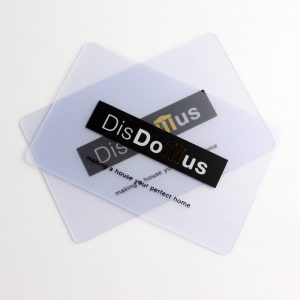
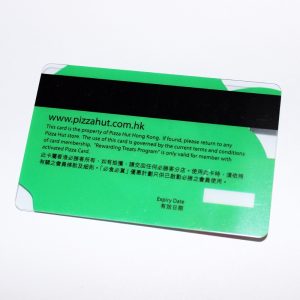
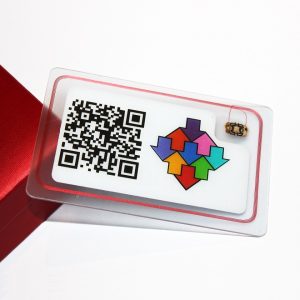
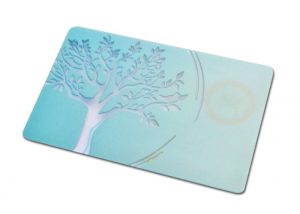
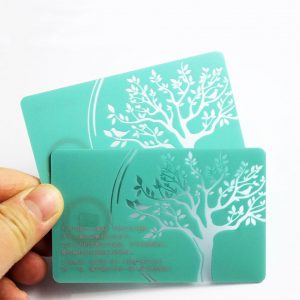
Product name: Hot Sale CR80 customized printing PVC transparent business cards
| Material | PVC, transparent PVC, ABS, PET | |||
| Size | 85.5*54mm or customized | |||
| Thickness | 0.76mm/0.3mm or customized | |||
| Application | finance, telecommunications, communications, transportation, tourism, health care, education,
hotels and businesses, enterprises micropayment, member store value, integral management system. |
|||
| Manufacturing technique | 1.Printing selection: silk-screen; offset print (CMYK four color printing), digital printing
2.Material selection: PVC, transparent PVC, ABS, PET 3.Card face effect selection: glossy, matte finish, frosting, mirror; transparent, translucent 4.Chips encapsulation:including EM,MATMEL,ST,TK serial etc. 5.High/low magnetic stripe can be sticked on the card, information encoding and encryption also available according to customer’s requirement.(three rail magnetic stripe) 6.One-dimensional bar code, two-dimensional bar code 7.Hot-stamping gold/sliver, Laser gold/sliver, Laser anti-counterfeiting effect 8. Spraying the code,scratch stripe (often used in rechargeable card, phone card, lucky draw card, etc.) 9.Big/small embossed number is available,hot stamping gold/silver can be used on it. (sequential code and unordered code are both available )10.Gold/silver/black thermal transfer number,laser code and UV code (sequential code and unordered code are both available) 11.Signature panel and tablet (hand writing area) 12. Round hole, square hole, hangtags hole, etc can be used on the card. |
Exchange business cards:
Business activities need to print personal business cards. When printing business cards, the column of one’s own position should not be exaggerated. It is best to print a variety of different business cards and give different business cards on different occasions.
During business activities, don’t forget to bring your business cards. Business cards should be stored in a special card holder. The card holder is best placed in the chest pocket of the jacket, not in the pocket of trousers.
When exchanging business cards, it is best to stand and hand them to the other party politely. If you are sitting, stand up and show respect when the other party walks over, and exchange business cards with each other after greeting the other party. Keep business cards clean and don’t hand out dirty business cards.
If you want to get the other party’s business card, and he did not take the initiative to give it, you can ask for it and say: “If there is no inconvenience, please give me a business card.”
People with lower status or lower positions or visitors should hand out their business cards first. If there are many visitors, you should first exchange business cards with the host or someone with a higher status inside.
Do not write or fold the business card on the spot after receiving the other party’s business card.
With the rapid development of computer technology, electronic business cards have become more and more popular, and exchanges have become more and more convenient. Use mobile phone business card recognition software to quickly identify business cards and convert them into electronic business cards, and at the same time generate personalized electronic business cards to show web pages, so that you can quickly share and exchange business cards. Representative products: custom business cards, business card all-rounder, etc., give business cards more More meaning.
user’s guidance:
You should deliver your business card every time you see a customer, not just at the first meeting.
Deliver business cards to everyone in an organization instead of just the boss of that organization.
Deliver two business cards instead of just one business card. The recipient is asked to forward another business card to someone else.
Put two business cards in each letter, birthday card, holiday card, and thank you letter.
Put two business cards in each media kit.
Special etiquette:
Distribute your business cards more generously and unrestrictedly outside the United States and Canada. In international business, people can not only formally give business cards to each other, but business cards can also be a valuable record, recording the people you meet, and also the basis for you to further contact them in the future.
However, you must clearly realize that in some cultures, there is a certain etiquette for exchanging business cards (unlike in North America, people can often exchange business cards informally). In Japan, the form of business card exchange is as important as the substance. The process of exchanging business cards is like a ballet with well-designed movements. The following are the specific steps:
- Hold the business card with the thumb and index finger of both hands. When handing out a business card, face the person receiving the business card. At the same time, bow slightly, that is, lower your head slightly.
- The party accepting the business card must nod his head to express gratitude, and at the same time hand out his business card in the same way, and then spend some time carefully reading the content on the business card. The reason is: the business card is your identity; it shows who you are, what you do, and who you work for-the business card is your appearance.
- Next, when appropriate, in these small ceremonies, everyone will have to hold their business cards in front of their chests so that the other party can recognize them.
- Try not to mark or mark on business cards.
In the Middle East and many Southeast Asian countries, you must use your right hand when handing out business cards. Never use your left hand, even if you are left-handed. In these areas, the left hand is used to clean up the body and is therefore considered a “dirty” hand.
Don’t put business cards in your pockets in any culture. We have noticed that a few informal Americans use business cards as toothpicks! (Across the table, your client must be thinking: “Hey! That’s my identity, not your toothpick.”)
Bilingual business cards:
When traveling in countries where English is not popularized, some knowledgeable tourists will use a business card printed with English on one side and the language of the local country on the other side. Make sure that the printing quality of the text on both sides is the same, so as not to inadvertently imply that the local language is a second-class language. In many big cities, there are many round-the-clock services in this area. If you go to a city like Tokyo or Hong Kong but don’t have a bilingual business card, then ask the hotel janitor where this service is available.
title:
In any case, you must make sure to write down your job title and title. Choose a title that can be understood by locals and reflect your position most accurately. For example, titles like “deputy” (deputy), “associate” or “executive assistant” can easily be confused outside the United States. The difference between words like “director” and “manager” is also difficult for people in many parts of the world to understand. The title of vice president is rarely used outside the United States, but businessmen from other countries know that it represents a special status. Also, abbreviations like CEO (CEO), CFO (Chief Financial Officer) and COO (Chief Operating Officer) also confuse people outside of North America.
In our English-speaking country, the “chairman” used by the British corresponds to the corporate title of the United States “president”. In the UK, “director” is a high-level position, which corresponds to the “vice president” in the United States; at the same time, this title also implies that this person is a member of the board of directors.
Two American business women recounted their experiences when they used business cards in Japan. One is the president of her company. In Japan, wherever she goes, she is always received by senior Japanese businessmen. On the other hand, the business card was marked as the director of international marketing, but she was treated in the exact opposite way—ignoring and blanking her eyes. Both of these ladies believe that in the Japanese business society, the status and position in the company is very important. As a result, the director of the international marketing department appointed herself as the president of “XX International Company” (the name of her own company) with the permission of their company. In fact, the name of this company is the official name of a foreign sales group. (FSC) is a department in charge of taxation, and she is right about her appointment. A few months later, this lady went to Japan again, and this time, the renamed “President” title on her business card gave her a very warm reception.
Warning: Don’t fabricate your title just to make a good impression. Otherwise, once your international colleagues find that you are bragging, you will lose your credibility, which is harmful and unhelpful in the long run.
Special reminder: In those countries and regions dominated by men (such as Latin America, Japan, South Korea, Saudi Arabia), if you are already married, you can consider adding “Mrs.” before your name to indicate your identity . The advantage of this is that it can prevent some unwanted offensives of love.
Our company:

Our factory:























